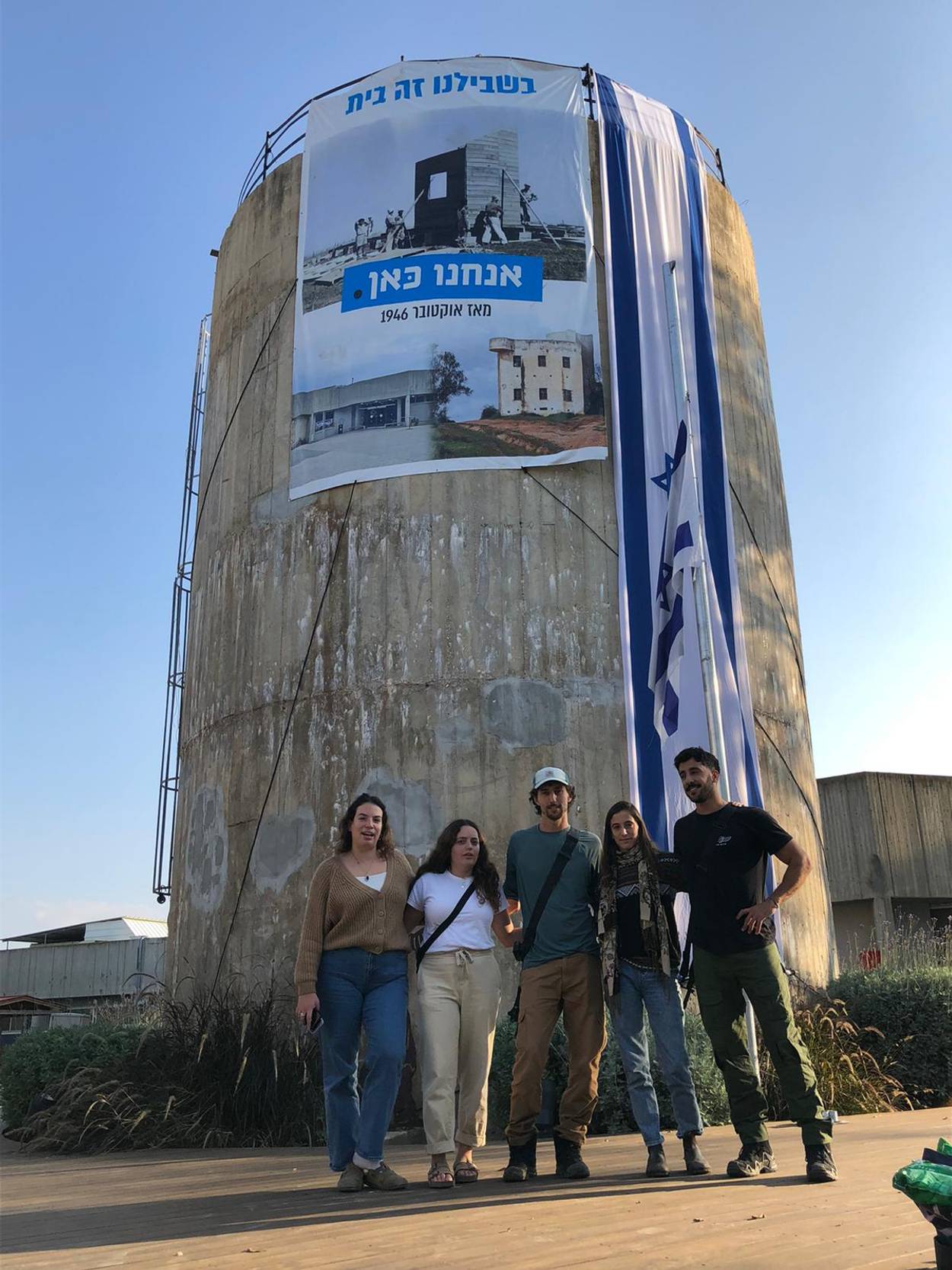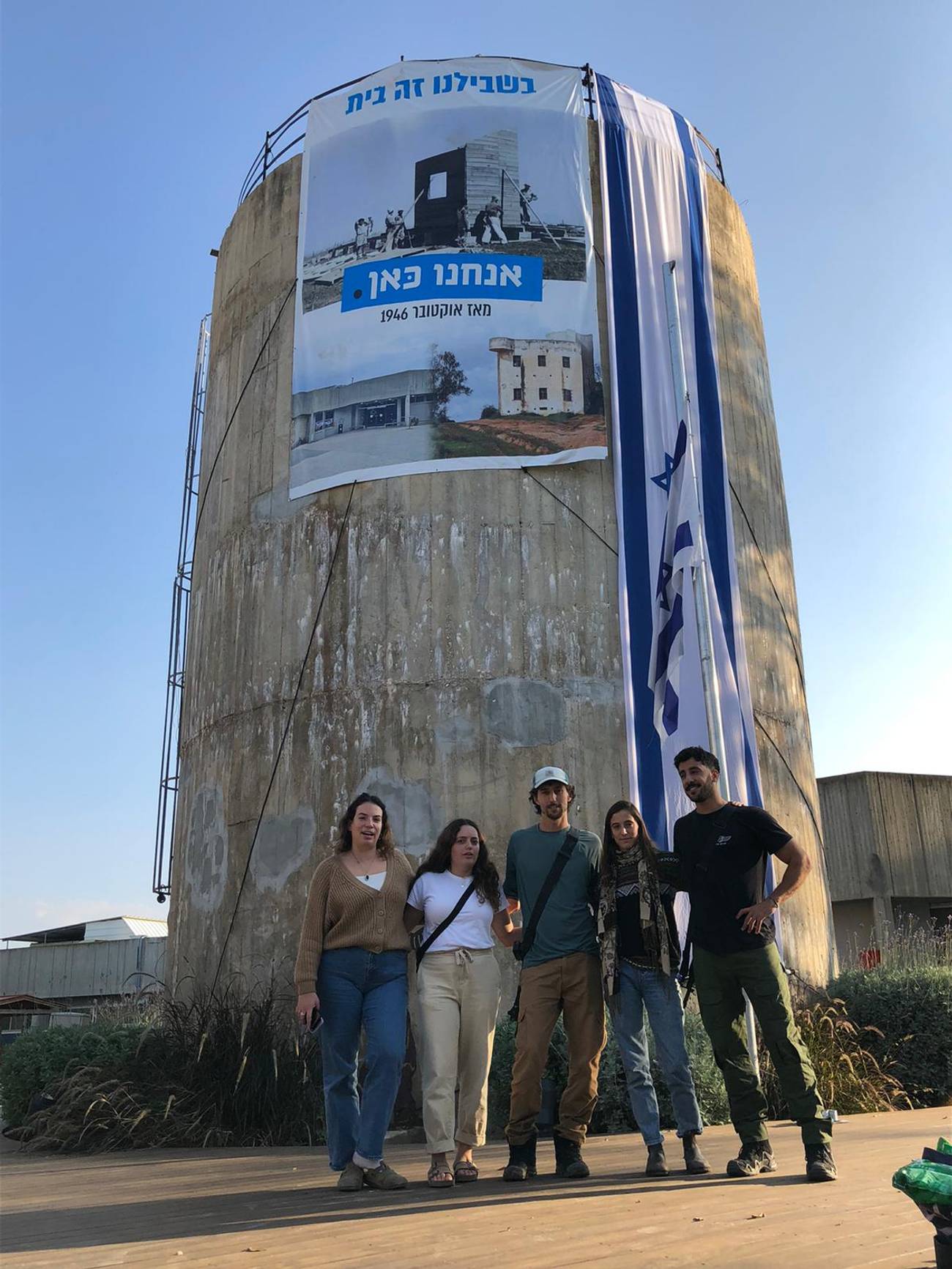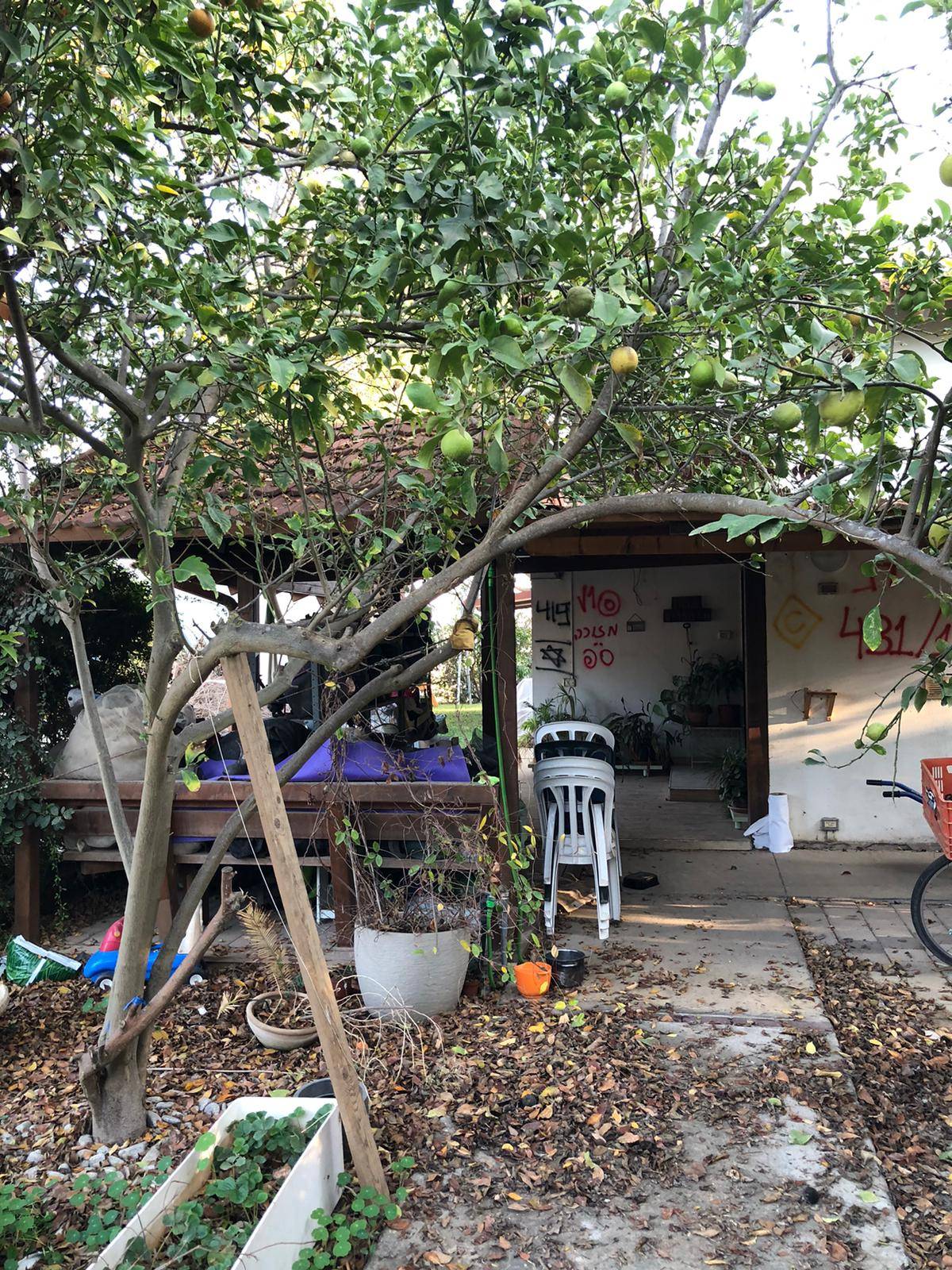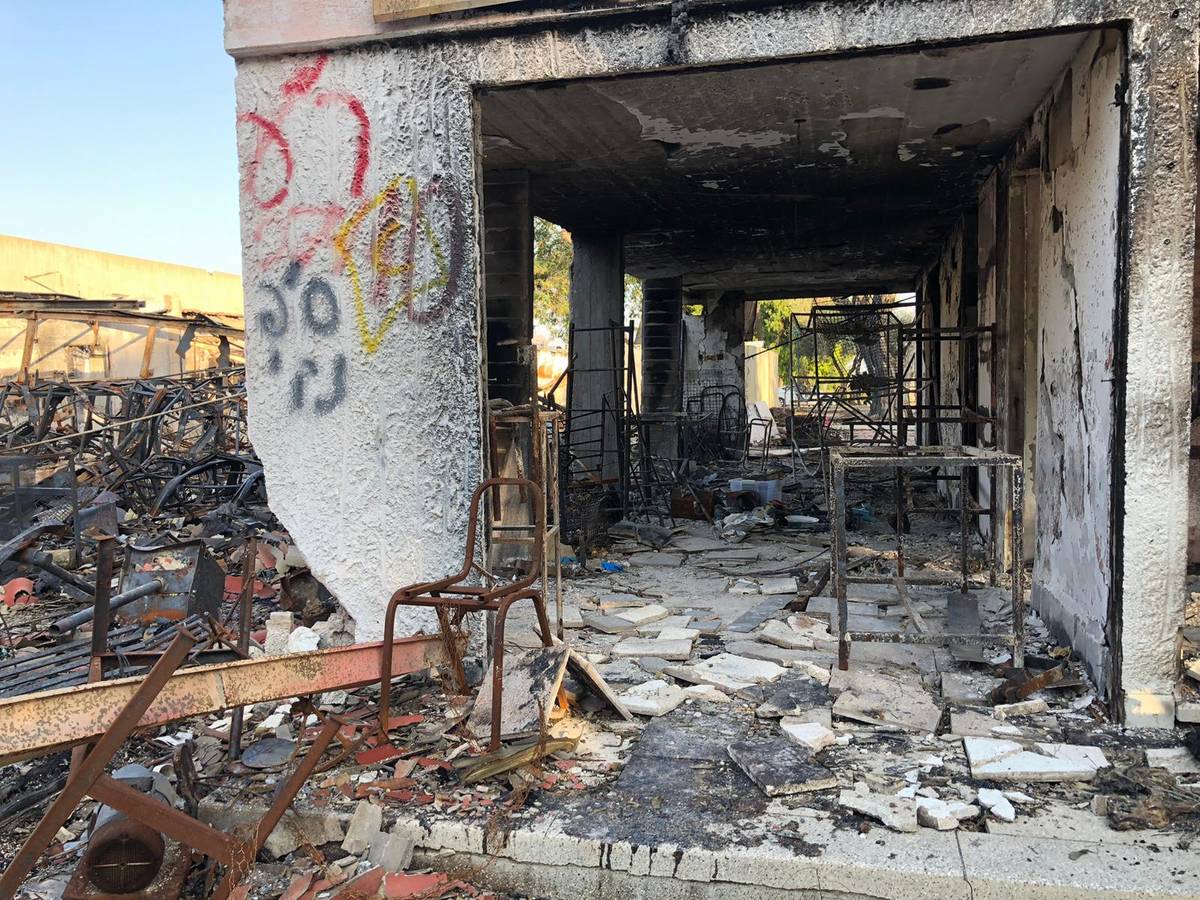Arise and Rebuild
Two months after the Hamas attack, many of Kibbutz Be’eri’s young adults have returned home, with an eye toward the future

Courtesy the author

Courtesy the author

Courtesy the author

Courtesy the author
At a house on Kibbutz Be’eri, bullet marks and grenade craters pock all four walls and the ceiling of the small bedroom where the Bachar family had retreated to stay alive on Oct. 7. Thirty exit holes from bullets could be counted on the inside of the bedroom’s door. In the frame of an upended, fractured futon rested a pink-covered children’s book, Little Cat, Big Cat.
The bedroom is where Hamas terrorists that day murdered the family’s mother, Dana, and her 15-year-old son, Carmel, and nearly murdered the father, Avida, and 13-year-old daughter, Hadar. Though the room was fortified, it failed to protect the Bachars.
The terrorists torched the house. It remains a burnt-out wreck of a two-story skeleton, a charred maze of walls stripped as if they were bark, that a visitor couldn’t imagine once hosted family meals and discussions and card games and arguments and movie nights and lovemaking and child-rearing.
The Bachars’ home is one of 100 on the kibbutz so ravaged that they’ll be razed and cleared.
But Be’eri also shows signs of life and a future, much of it thanks to its young-adult cohort who’d moved away from the kibbutz but returned to lend a hand in the hour of greatest need.
Some had relocated to Tel Aviv post-army to study and work. Others received military-reserve call-ups post-Oct. 7, only for their commanders, sensitive to the emotional upheaval, to dispatch them back to Be’eri to help the kibbutz cope.
Approximately 30 Be’eri natives in their 20s and 30s—among them the Bachars’ eldest child, son Rotem, 22, who’d been traveling in India on Oct. 7—are back and have committed to remaining, at least for the short term.
“We paused our lives,” said Ella Dvori, 22, who was set to visit India in November but canceled the trip and now intends to stay at Be’eri to assist for at least another year. “We’re not doing it for money, but for love. Now is the time to give back to the place we grew up in. The Tel Aviv apartment can wait.”
The 20- and 30-somethings explained that, as childless singles, they’re better able to live at Be’eri now—the terrorists didn’t target the neighborhood where the teens and young adults live, so their quarters are intact—while the rest of the kibbutz’s population remains at hotels to which they were evacuated at the Dead Sea and elsewhere in Israel.
Nearly all of the young kibbutzniks explained that they returned to help to rehabilitate Be’eri—“We did it without asking anyone,” said Noam Gold, 25—out of devotion to their families, their home community, and other residents who, regardless of bloodlines, are kin. Three interviewees, separately, called Be’eri “a Garden of Eden.”
During a visit on Dec. 6—a day short of two months since Hamas invaded Gaza-area communities, massacred 1,200 people, and kidnapped more than 240 people—I saw in this place a rural version of a ghost town, but one hinting at how the kibbutz functioned in normal times.
Be’eri Press—a well-known printing business—had already returned to operation soon after the massacre. The kibbutz also continues to raise cattle for meat and grow potatoes, peanuts, and citrus, work now carried on by kibbutzniks and outside volunteers.

Courtesy the author
That was about it until the young kibbutzniks extended the scope.
They’re incapable, of course, of handling the heavy work of contractors for clearing the wreckage, building new homes to replace the gutted ones, and renovating residences that can be salvaged. That won’t be happening in the affected communities until long after the war in Gaza ends, following what are sure to be protracted negotiations with government agencies on funding and compensation. Some Be’eri veterans think that will be at least five years down the road.
Already, Be’eri’s members turned down opportunities to resettle, even in the interim, in Jerusalem or the Negev.
What the young kibbutzniks have done is bring Be’eri onto the steppingstones of the lengthy path of returning the kibbutz to normalcy.
They took control over who entered the grounds, reopened the kibbutz’s offices, pushed for the dining room to again cook and serve meals, and got the exercise room operating again. They’re gardening, raking lawns, and removing light debris from paths. They’ve even gathered electric carts in an area protected from the winter rains. Next up will be reopening the laundry and restoring the lighting along walkways.
“We wanted to show the community that at some point, it’ll be possible to return here,” Dvori said. “The missions exist. They just need someone to carry them out.”
Count Haim Jelan, 65, a fan.
“Without them, this wouldn’t be happening. They’re running the kibbutz,” said Jelan, a Be’eri resident since 1976. “They’re laying the groundwork for when the [older] adults decide to return. I’m very impressed by them. This is the next generation. When you give them responsibility, they run with it.”
A 27-year-old Be’eri native named Dafna—as an active-duty officer in the Israel Defense Forces, she’s forbidden from providing her surname—put it this way on Dec. 11: “It’s my generation’s turn to guard the homeland. We have no other country.”
She said those words onstage at a Tel Aviv concert that raised funds for the revival of Be’eri. Dafna told of surviving the massacre in her family’s fortified room thanks to the bravery of her father, who shot three terrorists entering the home.
With that, the concert’s organizer, pianist Gil Shohat, took Dafna’s hand and uttered a prayer for Be’eri to arise stronger from the ashes.
“God not only chose your family, but you,” he told her.
“We came to hear music, not only about the horrors,” she said, before singing a duet with opera soprano Daniella Lugassy, “Ein Li Eretz Aheret” (I Have No Other Country), and then “At Telkhi Basadeh” (You’ll Walk in the Field).
The second number was a solo. But at Be’eri, it’s been a group effort.
On Oct. 7, 93 residents were murdered and 30 were kidnapped—totaling about 10% of the kibbutz’s prewar population of 1,250. (Twenty-one of the 30 were freed during the war’s recent pause; two of the nine people remaining in captivity are apparently dead, but Hamas still holds their bodies.)
The return of Be’eri will have to occur in stages, residents said. It’s far too soon to develop a formal plan to reconstitute the community and rebuild the homes, and each resident will have to decide whether he or she is willing to return to a place imbued with the terror and slaughter and ruin Hamas inflicted that day.
Everything depends, they said, on whether the IDF succeeds in the ongoing war in the Gaza Strip to destroy Hamas and return security to the Israeli region known as the Gaza Envelope.
During my visit, the IDF’s presence remained apparent—but mostly outside the kibbutz itself. Hundreds of soldiers encamped on a dirt field outside the entry gate. Music blared from one of the scores of military jeeps and armored personnel carriers parked there. Only some of the soldiers patrolled inside the kibbutz.
Removing the IDF from Be’eri, oddly enough, has been a key step in the kibbutz’s gradual return to normalcy. Even while explaining the move, several of the young residents wanted to assure that their comments wouldn’t be read as criticism of the IDF.
The problem, they said, is that the soldiers were making themselves too much at home in the property owners’ absence: helping themselves to families’ belongings, writing—even the day’s schedule—with markers on residents’ interior walls, sleeping in their beds, and leaving refuse everywhere.
It’s not that they evicted the soldiers from Be’eri—just encouraged the IDF to set up shop outside the kibbutz’s gates so as to reassert the kibbutz’s control over its grounds. The IDF got the message.
“The army can run the war from outside the kibbutz. They don’t have to be in homes,” said Dvori.
More upsetting to the residents, however, were Israeli civilians wandering onto the property in a form of macabre tourism.
“It was like a zoo, a safari,” said Gold. “Jewish people are nosy, curious. It’s an invasion of privacy.”
Knowing I’d feel intrusive visiting a site of such pain for its residents, I left my 35 mm camera at home and discreetly snapped just a few photographs that day with my smartphone. And while wanting to see some of the devastation, I waited until Dvori suggested a tour of the grounds.

Courtesy the author
We went in an electric cart, stopping at a flattened square of concrete and glass and wires. It was once a building that an IDF tank shell destroyed while battling terrorists on Oct. 7. It was one of the children’s houses—Be’eri is one of Israel’s few kibbutzim still operating communally, with children raised by caregivers and a fully functioning dining room. It’s where, in third and fourth grades, Dvori played with her friends following school.
“We’d come here in the afternoon. We’d watch TV and have activities,” she said.
Dvori continued along concrete paths, ones walked by generations of kibbutzniks and, doubtless, the Oct. 7 terrorists, too. We entered the Bachars’ home, which Dvori confirmed was OK with Rotem Bachar. We resumed driving and she pointed to homes lacking roofs, blown off by the arsonists. More evident were the rubble and debris. Most invaded homes showed black fire burns—and if you didn’t see it, you smelled it. Graffiti code scrawled beside a front door—the Hebrew letters samekh and peh—indicated that defense experts had inspected a home and declared it free of terrorists, bodies, weapons, and booby traps.
“There’s no house that hasn’t been gone through 1,000 times,” she said.
With my interviews and note-taking completed, the late afternoon called for a short walk. By now, the artillery booms and fighter-jet roars prompted less jumpiness than earlier in the day, although escaping the visual and audial contexts of war was near-impossible.
But the pastoral beauty of Be’eri remained. Surprisingly, the vast majority of the kibbutz seemed physically unscathed. Men could be spotted here and there on their roofs piling red shingles as if conducting normal maintenance. Artistic lawn adornments and clay flowerpots would beckon visitors, were there any. A yellow bicycle with a basket remained erect in someone else’s yard. A handwritten sign stuck to the front door of house No. 411/2 requested that no one change the lock. Trees swayed innocently in the late-autumn breeze. Birds sang as if in denial of the Oct. 7 horrors.
I stooped at points to retrieve a fallen grapefruit and three lemons. I’d use one lemon the next night hosting a family dinner on the first night of Hanukkah. Have a slice of a Be’eri lemon with tea, I told my guests. It’ll be meaningfully tart.
A man sat on his porch. He gazed in the same direction I did, so he didn’t notice my presence. My journalistic instinct nearly emitted a question about what he was pondering. I refrained, lacking the heart to utter a peep, to break the solitude that no doubt the man found calming on the splendid afternoon.
Hillel Kuttler, a writer and editor, can be reached at [email protected].